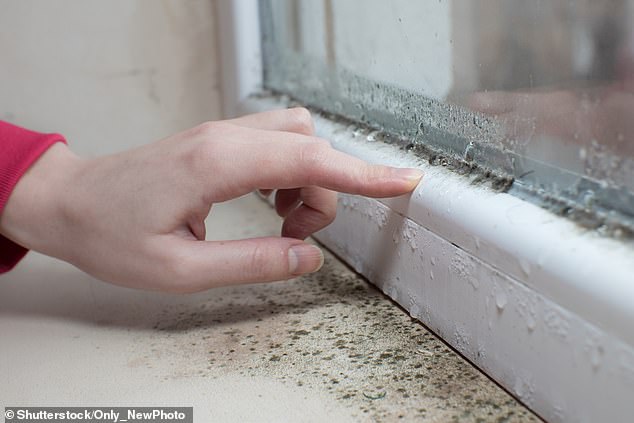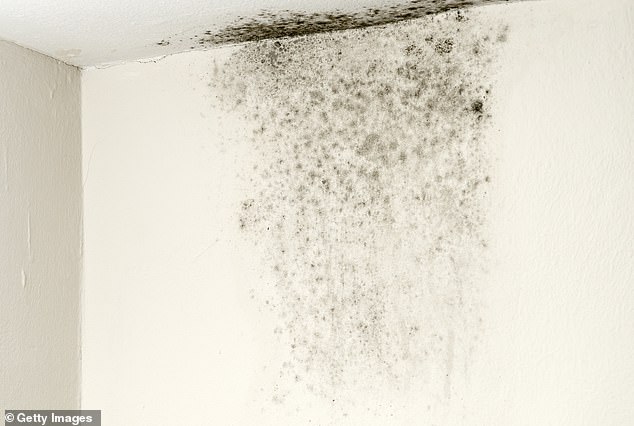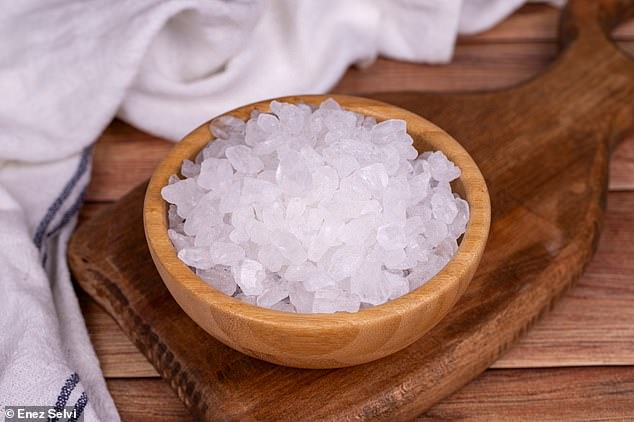As we enter autumn and temperatures steadily drop, toxic black mould will be a scourge of many households in the next few months.
But according to experts, a low-cost trick can stop the fungi from growing and ultimately make a difference to your family’s health.
It may sound bizarre, but experts are urging people to put a small bowl of salt next to windowsills.
The straightforward method can help combat the high-moisture conditions that allow toxic black mould to thrive.
Exposure to the unsightly mould can cause respiratory illnesses, allergies and asthma – and in some cases even be fatal.
‘A constant build up of condensation in the home isn’t great and in some cases it can cause mould growth which can be dangerous for your family,’ said Andy Ellis, home and garden expert at Posh.co.uk.
‘Simply fill a shallow bowl or a small jar with some salt – it’s a really easy trick that requires no effort at all.’
But does the technique work?
Due to activities like cooking, bathing, laundering clothes and even just breathing, air inside the home contains a certain small percentage of water vapour.
That’s why we notice drops of water dribbling down our windows during the autumn and winter months.
When the water vapour hits the windows, the cold surface turns the vapour into liquid water – what we know as condensation.
Unfortunately, the majority of toxic black mould growth in homes is caused by condensation, which helps provide a perfect habitat for the little fungi.
Mould spores quickly multiply once they find a damp surface – not just windows, but also walls, ceilings, pipes and more – which not only looks foul but can be detrimental to our health.
Exposure to this type of toxic black mould can make you more susceptible to respiratory infections, asthma and can even kill you in extremely rare cases.
That’s why experts suggest using salt, which is a ‘hygroscopic’ substance, meaning it absorbs moisture from the surrounding environment.
The idea is that a bowl of salt will draw in the water vapour from the air before it can hit the window, preventing condensation from happening.

‘Salt has the ability to naturally absorb moisture from the air and essentially dries it out,’ said Andy Ellis, home and garden expert at Posh.co.uk.
‘When it does come in contact with the glass, there are less droplets of condensation that will form.
‘The amount you use will vary depending on the size of the window you’re placing it next to.
‘Of course, generally speaking, the larger the window the more salt you’ll need, though usually one small bowl should be fine.’
The same bowl of salt should last ‘a couple of days’ before it needs to be replaced, according to the expert.
And it doesn’t matter too much if you use sea salt, rock salt or table salt, as they all have the same effect.
‘You’ll know when it’s time to replace it because the salt will appear damp and will begin to clump together,’ Mr Ellis added.
The one caveat is that salt only begins to absorb water vapour at relatively high humidity (a high concentration of water vapour in the air).

When there’s a relative humidity of less than 74 per cent, salt does not absorb water vapour in hugely significant quantities.
And the average humidity in British homes is only around the 50 per cent range.
In essence, the salt trick may not work in your house unless you have a really high amount of water vapour in the air – due to a high volume of activities such as boiling kettles, bathing and laundering.
One of the tried and tested ways to stop the growth of black mould is keeping windows open as much as possible.
This added ventilation allows moist, warm indoor air to escape and be replaced by drier, cooler outdoor air.
However, Brits can be adverse to doing this in winter because it lets the heat out.
So if you’re desperate to get rid of mould during the colder months, it may well be worth giving the salt bowl method a try.
All it’ll cost is a few grams of salt, which will be negligible in the battle to keep mould off your walls and surfaces.
Read more
- Is Kirstie Allsopp’s simple Lüften method the secret weapon against winter’s relentless mould invasion?
- Is Kirstie Allsopp’s secret to banishing black mould a simple, free daily routine?
- Could a ritual as simple as wide-open windows be the answer to all your mould and ventilation woes?
- Could this supermarket staple be the ultimate gamechanger for mold-free windows this winter?
- How low can you really go before inviting unwanted health risks and mould into your cosy haven?




